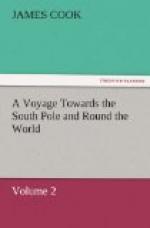Next morning at sun-rise, seeing neither land nor breakers, we bore away N.W. by W., and two hours after saw the reef extending N.W. farther than the eye could reach; no land was to be seen. It was therefore probable that we had passed its N.W. extremity; and, as we had seen from the hills of Balade its extent to the S.W., it was necessary to know how far it extended to the east or southeast, while it was in our power to recover the coast; for, by following the direction of the shoals, we might have been carried so far to leeward as not to be able to beat back without considerable loss of time. We were already far out of sight of land; and there was no knowing how much farther we might be carried, before we found an end to them. These considerations, together with the risk we must run in exploring a sea strewed with shoals, and where no anchorage, without them, is to be found, induced me to abandon the design of proceeding round by the N.W., and to ply up to the S.E., in which direction I knew there was a clear sea. With this view we tacked and stood to the S.E., with the wind at N.E. by E., a gentle breeze. At this time we were in the latitude of 19 deg. 7’ S., longitude 163 deg. 57’ E.
In standing to the S.E. we did but just weather the point of the reef we had passed the preceding evening. To make our situation the more dangerous the wind began to fail us; and at three in the afternoon it fell calm, and left us to the mercy of a great swell, setting directly on the reef, which was hardly a league from us. We sounded, but found no bottom with a line of two hundred fathoms. I ordered the pinnace and cutter to be hoisted out to tow the ship, but they were of little use against so great a swell. We, however, found that the ship did not draw near the reef so fast as might be expected; and at seven o’clock a light air at N.N.E. kept her head to the sea, but it lasted no longer than midnight, when it was succeeded by a dead calm.




